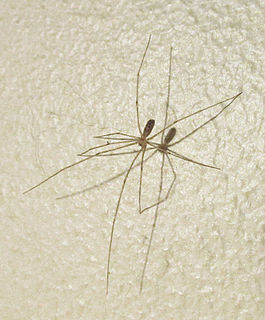
The sunbittern is a bittern-like bird of tropical regions of the Americas, and the sole member of the family Eurypygidae and genus Eurypyga. It is found in Central and South America, and has three subspecies. The sunbittern shows both morphological and molecular similarities with the kagu of New Caledonia, indicating a gondwanic origin, both species being placed in the clade Eurypygiformes.

Huntsman spiders, members of the family Sparassidae, are known by this name because of their speed and mode of hunting. They are also called giant crab spiders because of their size and appearance. Larger species sometimes are referred to as wood spiders, because of their preference for woody places. In southern Africa the genus Palystes are known as rain spiders or lizard-eating spiders. Commonly they are confused with baboon spiders from the Mygalomorphae infraorder, which are not closely related.

The Pholcidae are a family of araneomorph spiders. The family contains over 1,800 pholcids, including those commonly known as the marbled cellar spider , daddy long-legs spider, granddaddy long-legs spider, carpenter spider, daddy long-legger, vibrating spider, gyrating spider, long daddy, and skull spider. The family, first described by Carl Ludwig Koch in 1850, is divided into 94 genera.

The Goliath birdeater belongs to the tarantula family Theraphosidae. Found in northern South America, it is the largest spider in the world by mass – 175 g (6.2 oz) – and body length – up to 13 cm (5.1 in) – but it is second to the giant huntsman spider by leg span. It is also called the Goliath bird-eating spider; the practice of calling theraphosids "bird-eating" derives from an early 18th-century copper engraving by Maria Sibylla Merian that shows one eating a hummingbird. Despite the spider's name, it only rarely preys on birds.

Hamadruas is a genus of Asian lynx spiders that was first described by Christa Laetitia Deeleman-Reinhold in 2009.
Christa Laetitia Deeleman-Reinhold is a Dutch arachnologist. She graduated from the Leiden University in 1978. She specializes in spiders from Southeast Asia and Southern Europe, particularly cave-dwelling and tropical spiders. She donated a collection of about 25,000 Southeast Asian spiders, the largest collection of Southeast Asian spiders in existence, to the Naturalis Biodiversity Center in Leiden, The Netherlands. In addition to numerous articles, she has written the book Forest Spiders of South East Asia (2001). She is married to arachnologist Paul Robert Deeleman, with whom she has co-authored multiple publications.
Helia agna is a species of moth in the family Erebidae. It is found in North America. The MONA or Hodges number for Helia agna is 8657.
Baryphyma trifrons is a species of dwarf spider in the family Linyphiidae. It is found in North America, Europe, the Caucasus, and in a range from Russian Europe to the Far East).
Cesonia rothi is a species of ground spider in the family Gnaphosidae. It is found in the United States.

Enoplognatha caricis is a species of cobweb spider in the family Theridiidae. It is found in Europe, Turkey, a range within Russia, China, Korea, and Japan.

Psilochorus simoni is a species of cellar spider in the family Pholcidae. It is found in the United States, has been introduced into Europe, Turkey, and New Zealand.
Cheliferoides segmentatus is a species of jumping spider in the family Salticidae. It is found in a range from the United States to Guatemala.

Argyrodes nephilae is a species of cobweb spider in the family Theridiidae. It is found in a range from the United States to Argentina and the Galapagos Islands.

Cithaeron praedonius is a species of true spider in the family Cithaeronidae. It is found in North Africa, Greece, Cyprus, Turkey, India, and Malaysia, and has been introduced into Brazil, Cuba, America, and Australia.
Micaria pasadena is a species of ground spider in the family Gnaphosidae. It is found in the United States and Mexico.
Agroeca minuta is a species of liocranid sac spider in the family Liocranidae. It is found in the United States.

Hypochilus coylei is a species of lampshade weaver in the family of spiders known as Hypochilidae. It is found in the United States. This species inhabits a 35 mile north-south corridor of mountain range in western North Carolina. This species has a two year life cycle and feeds on crickets and spiders.
Hamataliwa grisea is a species of lynx spider in the family Oxyopidae. It is found in the United States and Mexico.
Hamataliwa unca is a species of lynx spider in the family Oxyopidae. It is found in the United States.









